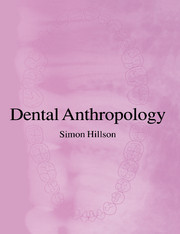Book contents
- Frontmatter
- Contents
- Acknowledgements
- Abbreviations
- 1 Introduction to dental anthropology
- 2 Dental anatomy
- 3 Variation in size and shape of teeth
- 4 Occlusion
- 5 Sequence and timing of dental growth
- 6 Dental enamel
- 7 Dentine
- 8 Dental cement
- 9 Histological methods of age determination
- 10 Biochemistry of dental tissues
- 11 Tooth wear and modification
- 12 Dental disease
- 13 Conclusion: current state, challenges and future developments in dental anthropology
- Appendix A: Field and laboratory methods
- Appendix B: Microscopy
- References
- Index
5 - Sequence and timing of dental growth
Published online by Cambridge University Press: 05 June 2012
- Frontmatter
- Contents
- Acknowledgements
- Abbreviations
- 1 Introduction to dental anthropology
- 2 Dental anatomy
- 3 Variation in size and shape of teeth
- 4 Occlusion
- 5 Sequence and timing of dental growth
- 6 Dental enamel
- 7 Dentine
- 8 Dental cement
- 9 Histological methods of age determination
- 10 Biochemistry of dental tissues
- 11 Tooth wear and modification
- 12 Dental disease
- 13 Conclusion: current state, challenges and future developments in dental anthropology
- Appendix A: Field and laboratory methods
- Appendix B: Microscopy
- References
- Index
Summary
Development of the dentition is important as the basis for age estimation in the remains of children. It has also been widely studied as part of a general investigation of the biology of growth.
Initiation and development of tooth germs
The surfaces lining an embryo's developing mouth are covered with a layer of tissue known as epithelium, and this is underlain by a tissue called mesenchyme, which will ultimately develop into different types of connective tissue – bone, cartilage, muscle, tendons and blood vessels, dentine and cement. At six weeks after fertilization, mesenchyme cells proliferate into an arch-shaped zone along the line of the developing jaws. Epithelium grows into this condensation to produce the so-called primary epithelial band (Figure 5.1), which itself divides into two lobes; the vestibular lamina and the dental lamina. Small swellings develop along the edge of the dental lamina so that, by the tenth week, there are ten of them for each jaw, and these are the enamel organs for the deciduous teeth, which will eventually form the enamel of their crowns. Enamel organs for the permanent dentition are initiated from around the sixteenth week after fertilization, with the latest of them appearing only after birth. This initial phase of tooth germ development is known as the bud stage, and next comes the cap stage when one side of the enamel organ bud develops a hollow, filled with mesenchyme called the dental papilla (Latin; nipple), and the mesenchyme outside forms a bag-like structure called the dental follicle (Latin folliculus; little bag).
- Type
- Chapter
- Information
- Dental Anthropology , pp. 118 - 147Publisher: Cambridge University PressPrint publication year: 1996
- 1
- Cited by

